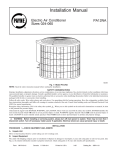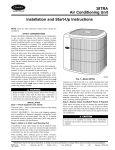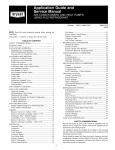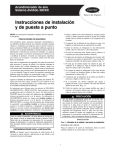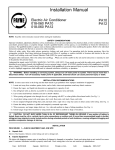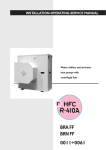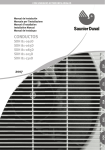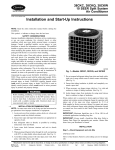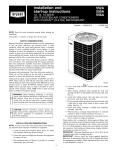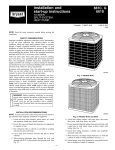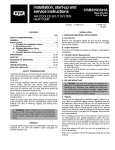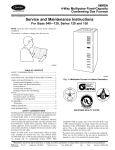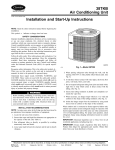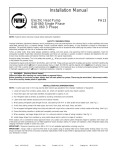Download installation and start-up instructions
Transcript
installation and start-up instructions 712A ELECTRIC AIR CONDITIONER Cancels: II 712A-24-1 II 712A-24-2 9-96 NOTE: Read entire instruction manual before starting installation. SAFETY CONSIDERATIONS Improper installation, adjustment, alteration, service, maintenance, or use can cause explosion, fire, electrical shock or other conditions which may cause personal injury or property damage. Consult a qualified installer, service agency, or your distributor or branch for information or assistance. The qualified installer or agency must use factory-authorized kits or accessories when modifying this product. Refer to the individual instructions packaged with the kits or accessories when installing. Follow all safety codes. Wear safety glasses and work gloves. Use quenching cloth for brazing operations. Have fire extinguisher available. Read these instructions thoroughly and follow all warning or cautions attached to the unit. Consult local building codes and National Electrical Code (NEC) for special requirements. . Recognize safety information. This is the safety-alert symbol When you see this symbol on the unit and in instructions or manuals, be alert to the potential for personal injury. Understand the signal word DANGER, WARNING, or CAUTION. These words are used with the safety-alert symbol. DANGER identifies the most serious hazards which will result in severe personal injury or death. WARNING signifies hazards that could result in personal injury or death. CAUTION is used to identify unsafe practices which would result in minor personal injury or product and property damage. A92461 Fig. 1—Model 712A When installing, allow sufficient space for airflow clearance, wiring, refrigerant piping, and service. Allow 30-in. clearance to service end of unit and 48 in. above unit. For proper airflow, a 6-in. clearance on 1 side of unit and 12 in. on all remaining sides must be maintained. Maintain a distance of 24 in. between units. Position so water, snow, or ice from roof or eaves cannot fall directly on unit. On rooftop applications, locate unit at least 6 in. above roof surface and mount on level platform or frame. Place unit above a load-bearing wall and isolate unit and tubing set from structure. Arrange supporting members to adequately support unit and minimize transmission of vibration to building. Consult local codes governing rooftop applications. NOTE: Unit must be level to within ±2° per compressor manufacturer specifications. WARNING: Before installing or servicing system, always turn off main power to system. There may be more than 1 disconnect switch. Turn off accessory heater power if applicable. Electrical shock can cause personal injury or death. INSTALLATION I. CHECK EQUIPMENT AND JOBSITE A. Unpack Unit Move to final location. Remove carton taking care not to damage unit. III. CHECK INDOOR AND OUTDOOR CHECK-FLORATER® PISTON Check indoor coil piston to see if it matches the required piston shown on unit rating label. If it does not match, replace indoor coil piston with piston shipped with unit. The piston shipped with outdoor unit is correct for any approved indoor coil combination. B. Inspect Equipment File claim with shipping company prior to installation if shipment is damaged or incomplete. Locate unit rating label on unit service panel. (See Fig. 2.) It contains information needed to properly install unit. Check rating label to be sure unit matches job specifications. IV. MAKE PIPING CONNECTIONS Outdoor units may be connected to indoor sections using service parts tubing package or field-supplied refrigerant grade tubing of correct size and condition. For tubing requirements beyond 50 ft substantial capacity and performance losses can occur. Follow long line guidelines to reduce these losses and improve system reliability. Refer to Table 1 for accessory requirements. Refer to Fig. 3 for field tubing equivalent line length. II. INSTALL ON A SOLID, LEVEL MOUNTING PAD If conditions or local codes require the unit be attached to pad, tie-down bolts should be used and fastened through knockouts provided in unit base pan. Refer to unit mounting pattern in Fig. 2 to determine base pan size and knockout hole locations. —1— SERIAL PROD UNIT RATING PLATE A MODEL ID PISTON OD FACTORY CHARGED R-22 Kg LBS AIR DISCHARGE AIR IN POWER SUPPLY VOLTS HZ PH PERMISSIBLE VOLTAGE AT UNIT AIR DISCHARGE MIN MAX SUITABLE FOR OUTDOOR USE COMPRESSOR VOLTS AC PH HZ RLA LRA FIELD POWER SUPPLY CONN 7/8″ DIA HOLE WITH 1 1/8″ DIA KNOCKOUT AND 1 3/8″ DIA KNOCKOUT FAN MOTOR VOLTS AC PH AIR IN FLA DESIGN/TEST PRESSURE GAGE AIR IN PSI kPa LO PSI kPa MINIMUM CIRCUIT AMPS FIELD CONTROL POWER SUPPLY CONN 7/8″ DIA HOLE MAX OVERCURRENT PROTECTIVE DEVICE TYPE AIR DISCHARGE USA CANADA MAX FUSE D TIEDOWN KNOCKOUTS (2) PLACES E DIA SERVICE LINE CONN HZ HI MAX HACR CKT-BKR MAX CKT-BKR N/A N/A ® ® CARRIER CORP INDIANAPOLIS IN 313948-401 REV A 46206 3/8″ DIA LIQUID TUBE CONN AIR IN C B A92490 UNIT SIZE 024 030, 036 042–060 A In. 30 30 30 B In. 23-1/2 23-1/2 23-1/2 C In. 6-1/2 6-1/2 6-1/2 D In. 10 10 10 E In. 5/8 3/4 7/8 Fig. 2—Unit Reference Drawing TABLE 1—REQUIRED FIELD-INSTALLED ACCESSORIES ACCESSORY Crankcase Heater Evaporator Freeze Thermostat Winter Start Control Compressor Start Assist (PTC) OR Capacitor/Relay Low-Ambient Controler Or Motor Master® Wind Baffle Coastal Filter Support Feet REQUIRED FOR LOW-AMBIENT APPLICATION YES REQUIRED FOR LONG-LINE APPLICATION YES REQUIRED FOR SEA COAST APPLICATION NO YES NO NO YES NO NO YES YES NO YES YES NO YES NO NO YES NO NO NO NO NO NO YES RECOMMENDED See Low-Ambient Instruction NO RECOMMENDED NOTE: In some cases noise in living area has been traced to gas pulsations from improper installation of equipment. A. 7. Do not suspend refrigerant tubing from joists and studs with a rigid wire or strap which comes in direct contact with tubing. (See Fig. 4.) Installation Recommendations 1. Locate unit away from windows, patios, decks, etc. where unit operations sounds may disturb customer. 8. Ensure that tubing insulation is pliable and completely surrounds vapor line. 2. Ensure that vapor and liquid line diameters are appropriate to capacity of unit. (See Table 2.) 9. When necessary, use hangar straps which are 1 in. wide and conform to shape of tubing insulation. (See Fig. 4.) 3. Run refrigerant tubes as directly as possible by avoiding unnecessary turns and bends. 10. Isolate hangar straps from insulation by using metal sleeves bent to conform to shape of insulation. 4. Leave some slack between structure and unit to absorb vibration. IMPORTANT: Always install a liquid line filter drier. Use P502-8083S for 024-036 size units. Use P502-8163S for 042-060 size units. Obtain filter driers from service parts 5. When passing refrigerant tubes through wall, seal opening with RTV or other pliable silicon-based caulk. (See Fig. 4.) If refrigerant tubes or indoor coil is exposed to atmospheric conditions for longer than 5 minutes, it must be evacuated to 500 microns to eliminate contamination and moisture in system. 6. Avoid direct lineset contact with water pipes, ductwork, floor joists, wall studs, floors, and walls. —2— A B C 90° LONG RAD 90° STD 45° STD A96414 TUBE SIZE OD (IN.) 5/8 3/4 7/8 1-1/8 90° STD 1.6 1.8 2.0 2.5 90° LR 1.0 1.2 1.4 1.7 45° STD 0.8 0.9 1.0 1.3 Fig. 3—Fitting Losses in Equivalent Ft. TABLE 2—REFRIGERANT CONNECTIONS AND RECOMMENDED LIQUID AND VAPOR TUBE DIAMETERS (IN.) UNIT SIZE 018, 024 030, 036 042, 048 060 LIQUID Connect Diameter 3/8 3/8 3/8 3/8 VAPOR Tube Diameter 3/8 3/8 3/8 3/8 Connect Diameter 5/8 3/4 7/8 7/8 Tube Diameter 5/8 3/4 7/8 1-1/8 VAPOR (LONG LINE) Connect Tube Diameter Diameter 5/8 3/4 3/4 7/8 7/8 1-1/8 7/8 1-1/8 IMPORTANT: Check factory tubing on both indoor and outdoor units to ensure tubes are not rubbing each other or sheet metal. Check feeder tubes. Make sure all wire ties on feeder tubes are secure and tight. CAUTION: DO NOT BURY MORE THAN 36 IN. OF REFRIGERANT TUBING IN GROUND. If any section of tubing is buried, there must be a 6-in. vertical rise to valve connections on outdoor unit. If more than recommended length is buried, refrigerant may migrate to cooler buried section during extended periods of unit shutdown, causing refrigerant slugging and possible compressor damage at start-up V. MAKE ELECTRICAL CONNECTIONS WARNING: To avoid personal injury or death, do not supply power to unit with compressor terminal box cover removed. B. Outdoor Units Connected to Factory-approved Indoor Units Outdoor unit contains correct system refrigerant charge for operation with indoor unit of same size when connected by 15 ft of field-supplied or factory accessory tubing. Check refrigerant charge for maximum efficiency. (See Section IX—Checking Charge.) Be sure field wiring complies with local and national fire, safety and electrical codes, and voltage to system is within limits shown on unit rating label or instruction supplement. Contact local power company for correction of improper voltage. See unit rating label for recommended circuit protection device. NOTE: Operation of unit on improper line voltage constitutes abuse and could affect unit reliability. See unit rating label. Do not install unit in system where voltage or phase imbalance may fluctuate above or below permissible limits. C. Refrigerant Tubing Connect tubing to fittings on outdoor unit vapor and liquid service valves. (See Fig. 2.) CAUTION: To avoid valve damage while brazing, service valves must be wrapped with a heat-sinking material such as a wet cloth. NOTE: Use copper wire only between disconnect switch and unit. NOTE: Install branch circuit disconnect per NEC of adequate size to handle unit starting current. Locate disconnect within sight from and readily accessible from unit, per Section 440-14 of NEC. D. Sweat Connection Use refrigerant grade tubing. Service valves are closed from factory and ready for brazing. After wrapping service valve with a wet cloth, tubing set can be brazed to service valve using either silver bearing or non-silver bearing brazing material. Consult local code requirements. Refrigerant tubing and indoor coil are now ready for leak testing. This check should include all field and factory joints. A. Route Ground and Power Wires Remove access panel to gain access to unit wiring. Extend wires from disconnect through power wiring hole provided and into unit control box. (See Fig. 2.) —3— DISCONNECT PER N.E.C. AND/OR LOCAL CODES NOTE: AVOID CONTACT BETWEEN TUBING AND STRUCTURE OUTDOOR WALL CONTACTOR INDOOR WALL FIELD POWER WIRING CAULK FIELD GROUND WIRING GROUND LUG A88174 INSULATION Fig. 5—Line Power Connections (1 Phase) THROUGH THE WALL VAPOR LINE LIQUID LINE VI. COMPRESSOR CRANKCASE HEATER A crankcase heater is required if refrigerant tubing is longer than 50 ft. See Long Line Application Guideline. JOIST HANGER STRAP (AROUND VAPOR LINE ONLY) VII. INSTALL ELECTRICAL ACCESSORIES Refer to individual instructions packaged with kits or accessories when installing. VAPOR LINE VIII. START-UP 1. When equipped with a crankcase heater, energize heater a minimum of 24 hrs before starting unit. To energize heater only, set thermostat to OFF position and close electrical disconnect to outdoor unit. CAUTION: Service valve gage ports are equipped with Schrader valves. To prevent personal injury, wear safety glasses and gloves when handling refrigerant. INSULATION 1″ MIN LIQUID LINE SUSPENSION 2. Fully open liquid and vapor service valves. A92469 3. Unit is shipped with valve stem(s) front seated, and caps installed. Replace stem caps after system is opened to refrigerant flow. Replace caps finger-tight and tighten additional 1/6th turn with wrench. Fig. 4—Piping Installation WARNING: According to NEC, ANSI/NFPA 70, and local codes, cabinet must have an uninterrupted or unbroken ground, to minimize personal injury if an electrical fault should occur. The ground may consist of electrical wire or metal conduit when installed in accordance with existing electrical codes. Failure to follow this warning could result in an electric shock, fire, or death. 4. Close electrical disconnects to energize system. 5. Set room thermostat at desired temperature. Be sure set point is below indoor ambient temperature. 6. Set room thermostat at COOL and fan switch at FAN or AUTO, as desired. Operate unit for 15 minutes. Check system refrigerant charge. See Checking Charge section below. B. Connect Ground and Power Wires Connect ground wire to ground connection in control box for safety. Connect power wiring to contactor. (See Fig. 5.) C. Connect Control Wiring Route 24-v control wires through control wiring grommet and connect leads to control wiring. (See Fig. 6.) Use No. 18 AWG color-coded, insulated (35° C minimum) wires. If thermostat is located more than 100 ft from unit, as measured along control voltage wires, use No. 16 AWG color-coded wires to avoid excessive voltage drop. Use furnace transformer, fan-coil transformer, or accessory transformer for control power, 24-v/40-va minimum. NOTE: Use of available 24-v accessories may exceed minimum 40-va power requirement. Determine total transformer loading and increase transformer capacity or split load with an accessory transformer as required. IMPORTANT: Check factory wires and wire connection to ensure terminations are secured properly. Check wire routing to insure wires are not in contact with tubing or sheet metal. WARNING: Relieve pressure and recover all refrigerant before system repair or final unit disposal to avoid personal injury or death. Use all service ports and open all flow control devices, including solenoid valves. IX. CHECKING CHARGE A. Unit Charge Factory charge is shown on unit rating label or installation supplement. NOTE: If superheat or subcooling charging conditions are not favorable, charge must be weighed in accordance with unit rating plate + or -0.6 oz/ft of 3/8 liquid line above or below 15 ft respectively. Example: 25-15=10 x 0.6= 6 oz of additional charge. —4— TRANS SEE NOTE 2 THERMOSTAT SUBASE TRANS MIN 60VA 4 RH RC R LLS NC LEAVE JUMPER ON SUBASE (RH TO RC) LLS NC B Y1 Y Y2 TO IFM LINE VOLTAGE POWER SUPPLY G Y BLU C BRN COND UNIT G BLU C BRN IFR IFR W1 A W2 W ARRANGEMENT A–COOLING ONLY 4 TO IFM LINE VOLTAGE POWER SUPPLY C HC2 HC1 ARRANGEMENT C–1 TRANSFORMER; COOLING AND 2-STAGE HEATING TRANS SEE NOTE 2 ADD JUMPER R LLS NC Y TO IFM LINE VOLTAGE POWER BLU C BRN SUPPLY NOTES: 1. REFER TO UNIT LABEL WIRING DIAGRAM FOR WIRE COLORS. IFR, IFM AND LLS ARE LOCATED INDOORS ON HEATING-COOLING APPLICATIONS. IF ACCESSORY IFR IS REQUIRED FOR COOLINGONLY APPLICATIONS, LOCATE IFR IN FAN COIL. 2. N.E.C. CLASS 2, 24V CIRCUIT, MIN 40VA REQUIRED. C – CONTACTOR HC – HEATING CONTROL IFM – INDOOR FAN MOTOR LLS – LIQUID LINE SOLENOID VALVE NC – NORMALLY CLOSED TRANS – TRANSFORMER G IFR A W HC ARRANGEMENT B – 1 TRANSFORMER; COOLING AND 1-STAGE HEATING A93199 Fig. 6–Typical 24-v Circuit Connections 7. If unit has a higher suction line temperature than charted CAUTION: Compressor damage may occur if system is temperature, add refrigerant until charted temperature is overcharged. reached. 8. If unit has a lower suction line temperature than charted temperature, reclaim refrigerant until charted temperature is reached. CAUTION: Do not vent refrigerant to atmosphere. Recover during system repair or final unit disposal. B. 9. If outdoor air temperature or pressure at suction valve changes, charge to new suction line temperature indicated on chart. Cooling Only Procedure 10. This procedure is valid when indoor air flow is within ±21 percent of its rated CFM. IMPORTANT: Before leaving job site ensure all panels and covers are securely fastened. Service valve stem caps should be tightened 1/6th turn past finger tight. 1. Operate unit a minimum of 10 minutes before checking charge. 2. Measure suction pressure by attaching a gage to suction valve service port. 3. Measure outdoor air dry-bulb temperature with thermometer. 4. Measure indoor air (entering indoor coil) wet-bulb temperature with a sling psychrometer. 5. Refer to Table 3. Find outdoor temperature and evaporator entering air wet-bulb temperature. At this intersection note superheat. 6. Refer to Table 4. Find superheat temperature located in step 6 and suction pressure. At this intersection note suction line temperature. CARE AND MAINTENANCE For continuing high performance, and to minimize possible equipment failure, it is essential that periodic maintenance be performed on this equipment. Consult your servicing contractor or User’s Manual for proper frequency of maintenance. Frequency of maintenance may vary depending upon geographic areas, such as coastal applications. Leave User’s Manual with homeowner. Explain system operation and maintenance procedures outlined in manual. —5— →TABLE 3—SUPERHEAT CHARGING OUTDOOR TEMP °F 55 60 65 70 75 80 85 90 95 100 105 110 115 50 9 7 — — — — — — — — — — — 52 12 10 6 — — — — — — — — — — 54 14 12 10 7 — — — — — — — — — 56 17 15 13 10 6 — — — — — — — — 58 20 18 16 13 9 5 — — — — — — — EVAPORATOR ENTERING AIR °F WB 60 62 64 66 68 23 26 29 32 35 21 24 27 30 33 19 21 24 27 30 16 19 21 24 27 12 15 18 21 24 8 12 15 18 21 — 8 11 15 19 — 5 9 13 16 — — 6 10 14 — — — 8 12 — — — 5 9 — — — — 6 — — — — — 70 37 35 33 30 28 25 22 20 18 15 13 11 8 72 40 38 36 33 31 28 26 24 22 20 17 15 14 74 42 40 38 36 34 31 30 27 25 23 22 20 18 76 45 43 41 39 37 35 33 31 29 27 26 25 23 NOTE: Superheat °F is at low-side service port. →TABLE 4—REQUIRED SUCTION TUBE TEMPERATURE °F SUPERHEAT TEMP °F 0 2 4 6 8 10 12 14 16 18 20 22 24 26 28 30 32 34 36 38 40 61.5 35 37 39 41 43 45 47 49 51 53 55 57 59 61 63 65 67 69 71 73 75 64.2 37 39 41 43 45 47 49 51 53 55 57 59 61 63 65 67 69 71 73 75 77 67.1 39 41 43 45 47 49 51 53 55 57 59 61 63 65 67 69 71 73 75 77 79 SUCTION PRESSURE AT SERVICE PORT PSIG 70.0 73.0 76.0 79.2 41 43 45 47 43 45 47 49 45 47 49 51 47 49 51 53 49 51 53 55 51 53 55 57 53 55 57 59 55 57 59 61 57 59 61 63 59 61 63 65 61 63 65 67 63 65 67 69 65 67 69 71 67 69 71 73 69 71 73 75 71 73 75 77 73 75 77 79 75 77 79 81 77 79 81 83 79 81 83 85 81 83 85 87 —6— 82.4 49 51 53 55 57 59 61 63 65 67 69 71 73 75 77 79 81 83 85 87 89 85.7 51 53 55 57 59 61 63 65 67 69 71 73 75 77 79 81 83 85 87 89 91 SERVICE TRAINING Packaged Service Training programs are an excellent way to increase your knowledge of the equipment discussed in this manual, including: • Unit Familiarization • Maintenance • Installation Overview • Operating Sequence A large selection of product, theory, and skills programs is available, using popular video-based formats and materials. All include video and/or slides, plus companion book. Classroom Service Training plus "hands-on" the products in our labs can mean increased confidence that really pays dividends in faster troubleshooting, fewer callbacks. Course descriptions and schedules are in our catalog. CALL FOR FREE CATALOG 1-800-962-9212 [ ] Packaged Service Training [ ] Classroom Service Training A94328 —7— © 1996 BDP Co. • P.O. Box 70 • Indianapolis, IN 46206 Printed in U.S.A. —8— 712a996 Catalog No. PA-3371-202








